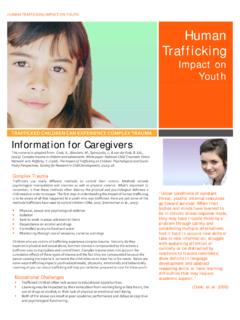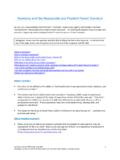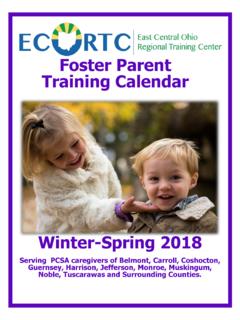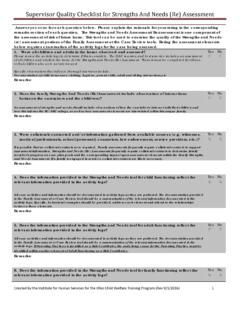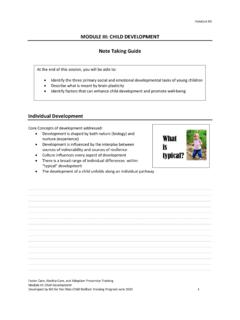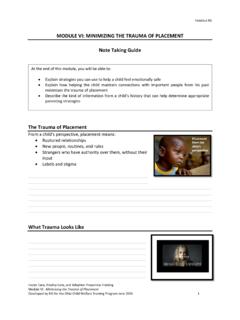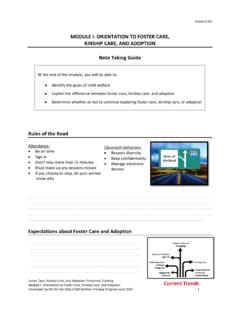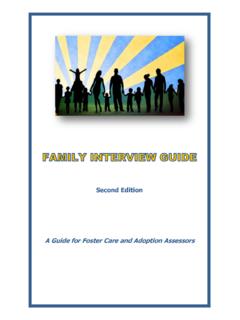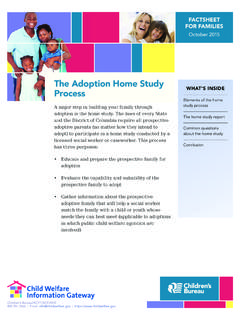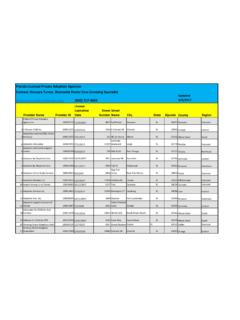Transcription of MODULE II: THE CHILD PROTECTION TEAM Note …
1 Handout #1 MODULE II: THE CHILD PROTECTION team Note Taking Guide At the end of this MODULE , you will be able to: Identify the members of the CHILD welfare team and the role of these members in serving a CHILD Identify advantages and challenges to teaming Describe the life of a CHILD welfare case from allegation to permanency (reunification, legal custody, adoption) Understanding the CHILD Welfare System The role of CHILD welfare is to identify and protect children at risk. There is a continuum of services and foster care is just one component of that continuum. There is a system of checks and balances to protect the rights of the CHILD , the family, and the community.
2 _____. _____. _____. _____. _____. _____. _____. _____. _____. _____. _____. _____. _____. _____. _____. _____. _____ Foster Care, Kinship Care, and Adoption Preservice Training MODULE II: The CHILD PROTECTION team Developed by IHS for the Ohio CHILD Welfare Training Program June 2015 1 Handout #1 History of Foster Care in the US A summary of major CHILD welfare legislation can be found at: egis/ _____. _____. _____. _____. _____. _____. _____. _____. _____. _____. _____. _____. _____. _____ The team Approach team members must have a shared goal, a plan for reaching the goal, and an effective communication system.
3 As a team member, you should advocate for all children by reporting suspected abuse or neglect, educating others, recruiting, and being active in associations. You should advocate for the children in your home by providing for their safety and well being, ensuring participation in age . appropriate activities, modeling, coaching, and suporting primary parents. _____. _____. _____. _____. _____. _____. _____. _____ _____. _____. Foster Care, Kinship Care, and Adoption Preservice Training MODULE II: The CHILD PROTECTION team Developed by IHS for the Ohio CHILD Welfare Training Program June 2015 2 Handout #1 _____.
4 _____. _____. _____ _____. _____. _____. _____. _____. _____ List three ways you will use the information from this training. 1. 2. 3. Foster Care, Kinship Care, and Adoption Preservice Training MODULE II: The CHILD PROTECTION team Developed by IHS for the Ohio CHILD Welfare Training Program June 2015 3 Handout #2 MODULE II: THE CHILD PROTECTION team Overview of Foster Care RESPONSIBILITIES OF CHILDREN SERVICES To investigate allegations of abuse and neglect, determine whether the CHILD 's immediate safety and can be ensured within his or her own family, and assess the potential risk for future maltreatment To identify the factors in the family that create risk, and the family strengths and resources that can be used to help reduce and remove risk To provide protective services to children in their own homes, whenever possible, to prevent the trauma inherent in separation and placement When necessary.
5 To place the CHILD temporarily with a culturally sensitive and supportive family that meets the CHILD 's individual needs, as close to the CHILD 's own home as possible To work toward permanence for the CHILD , from the moment of placement in a foster home (the first choice is most often to strengthen the CHILD 's family and reunify that CHILD ) To secure a permanent alternative home for the CHILD when he or she cannot return home TIMELINE OF A CHILD 'S JOURNEY THROUGH PLACEMENT Practices may vary a bit from one county to another, but outlined below is the sequence of events that determine how a case progresses from intake to foster care placement to permanence.
6 Agencies receive referrals of CHILD maltreatment from a variety of sources including: o Mandated reporters such as teachers, members of the clergy, social workers, and law enforcement who are required to report suspicions of CHILD maltreatment o Community members such as a neighbor or family friend o Concerned family members o Self Referrals Ohio CHILD welfare agencies use standardized tools and assessment protocols to make decisions about a CHILD 's immediate safety and potential risk for future maltreatment. The same set of assessment tools are used by every caseworker throughout Ohio. The intake caseworker uses a standardized safety assessment tool to determine whether the CHILD 's immediate safety can be ensured within his or her own family.
7 The caseworker also determines what services are necessary to support the family and ensure safety for the CHILD . Foster Care, Kinship Care, and Adoption Preservice Training MODULE II: The CHILD PROTECTION team Developed by IHS for the Ohio CHILD Welfare Training Program June 2015 1 Handout #2 If temporary placement outside of the home is needed to ensure the CHILD 's safety, kinship caregivers (relatives or other strong family connections) are sought so the CHILD can be cared for by individuals within the CHILD 's attachments, family system, neighborhood, and culture. If no kin can be identified or located or none can provide safety, the CHILD is removed and placed in a licensed foster home.
8 Temporary custody is awarded to the agency (not the foster caregivers) by Juvenile Court so the CHILD 's safety can be ensured. Attempts are made to keep siblings together. If the agency does not already hold temporary custody of the CHILD , the agency must file a complaint in the county's Juvenile Court within one business day of the CHILD 's removal from his family. By the 90th day after the CHILD 's removal from his family, a dispositional hearing is held in Juvenile Court, and a case plan is filed to identify the goal of the agency in meeting the best interests of the CHILD . If the goal is reunification (the most commonly applied goal in CHILD welfare), expectations of both the family and the agency in working to achieve reunification are outlined.
9 Six months after the CHILD 's removal from the home, an administrative review, often called the Semi Annual Review (SAR), is held with parents, foster caregivers, agency staff, and other service providers to determine progress in meeting the case plan goals. Revisions or addendums to the case plan can be made at this time. At this point in the case a reunification assessment will also be completed for children who have been placed out of the home for thirty days or more. The reunification assessment considers: o Whether there are active safety threats present in the home of origin preventing the return of the CHILD o The parents' readiness for the CHILD to return home o The CHILD 's readiness to return home Twelve months after the CHILD 's removal, a dispositional hearing is held to review progress toward the identified permanency goal.
10 At this time, the court may choose one of the following options: o Return the CHILD to the primary parent(s) with no restrictions o Return the CHILD home with protective supervision by the agency o Give legal custody to kin o Appoint a legal guardian o Terminate parental rights and give permanent custody of the CHILD to the agency for purposes of adoption o Extend the agency's temporary custody of the CHILD up to six months due to extenuating circumstances o Change the CHILD 's legal status to Planned Permanent Living Arrangement (PPLA). This legal status is only given to youth older than sixteen when the agency can show the court that it is not in the CHILD 's best interest to returned home, adopted, placed with a legal guardian, or placed with a fit and willing relative (PL 113 183) Foster Care, Kinship Care, and Adoption Preservice Training MODULE II: The CHILD PROTECTION team Developed by IHS for the Ohio CHILD Welfare Training Program June 2015 2 Handout #3 MODULE II: THE CHILD PROTECTION team Scenario #I and #II Scenario #I You are an adoption social worker at a public agency.
